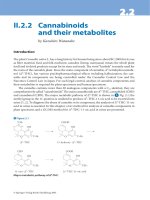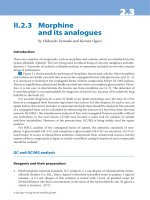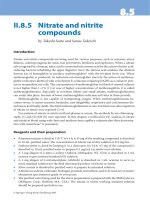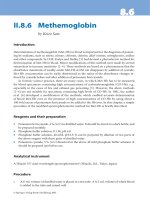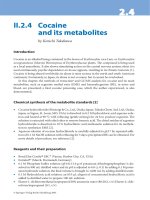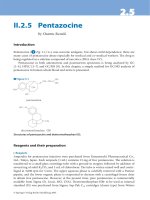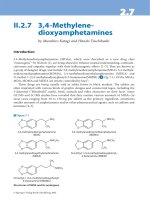Drugs and Poisons in Humans - A Handbook of Practical Analysis (Part 17)
Bạn đang xem bản rút gọn của tài liệu. Xem và tải ngay bản đầy đủ của tài liệu tại đây (181.19 KB, 6 trang )
1. 81. 8
© Springer-Verlag Berlin Heidelberg 2005
II.1.8 Alkyl nitrites
by Yasuo Seto
Introduction
Alkyl nitrites are highly volatile organic solvents of aliphatic alcohol esters of nitrites [1]. Amyl
nitrite
a
, butyl nitrite and isobutyl nitrite are the representative alkyl nitrites; their boiling points
are 98, 78 and 67 °C, respectively. Amyl nitrite is being widely used as a detoxicant for cyanide
poisoning, because alkyl nitrites oxidize hemoglobin in erythrocytes to yield methemogloblin,
which is bound with cyanide to inactivate it [1]. Alkyl nitrites also show a coronary artery-di-
lating e ect, and had been, therefore, used for the treatment of angina pectoris many years ago
[2]; the pharmacological e ect of the dilation of the coronary arteries was found due to the
action of nitrogen monoxide produced by decomposition of alkyl nitrites [3]. ey are being
mainly used as materials for manufacturing drugs or as reagents for synthesis in industries;
they are also used as aromatics. Because of their pharmacological e ect, alkyl nitrites are being
abused as uncontrolled inhalant drugs and causing a social problem [4]. Although there are
many reports on toxic and fatal cases due to alkyl nitrites [5], reports on their fatal doses are
few; it is estimated that oral ingestion of 10–15 mL of each alkyl nitrite causes serious methe-
moglobinemia [6]. e LD
50
value for an alkyl nitrite is reported to be 205 mg/kg. ere are not
many cases of analysis of alkyl nitrites in the eld of forensic toxicology. In this chapter, the
methods for analysis of the compounds by headspace (HS)-gas chromatography (GC) and
liquid-liquid extraction-GC are presented.
Determination of isobutyl nitrite in aqueous solution
by headspace-GC
Reagents and their preparation
• A 115-µL volume (100 mg) of isobutyl nitrite (Tokyo Kasei Kogyo Co., Ltd., Tokyo, Japan
and other manufacturers) is dissolved in acetone to prepare 10 mL stock solution (10 mg/
mL, preservable for a week in a refrigerator)
b
. e stock solution is diluted 2,000-fold with
acetone to prepare standard solution (5 µg/mL).
• A 124-µL volume (100 mg) of isobutyl alcohol (obtainable from many manufacturers) is
dissolved in acetone to prepare 10 mL stock solution (10 mg/mL, preservable in an airtight
container at room temperature). e stock solution is diluted 2,000-fold with acetone to
prepare standard solution (5 µg/mL).
154 Alkyl nitrites
GC conditions
GC column: a polar fused silica capillary column ( HP-Wax, 30 m × 0.25 mm i. d., lm thick-
ness 0.25 µm, Agilent Technologies, Palo Alto, CA, USA).
GC conditions
c
: an HP 6890 Series gas chromatograph (Agilent Technologies); injection
mode: split with its ratio 30; injection temperature: 200 °C; detector: FID; detector tempera-
ture: 220 °C; carrier gas: He; its ow rate: 0.67 mL/min; column (oven) temperature: 40 °C
(3 min) → 15 °C/min → 115 °C.
MS conditions: transfer line temperature: 280 °C; ion source temperature: 200 °C; ioniza-
tion mode: EI; electron energy: 70 eV; ionization current: 60 µΑ.
Procedure
i. A 0.25-mL volume of a specimen
d
, 0.5 mL of 1 M phosphate bu er solution (pH 7), 0.2 mL
distilled water and 0.05 mL acetone are placed in a glass vial with a septum screw cap (8 mL
volume, external diameter 17 mm, height 6 cm, GL Sciences, Tokyo, Japan) and airtightly
stoppered with a cap with a Tuf-Bond
TM
disc (PTFE/silicone septum).
ii. e vial is incubated at 30 °C for 10 min on a Type-D aluminum block heater (Reacti-
erm
TM
, Pierce, Rockford, IL, USA) to gain an equilibrium.
iii. A 0.5-mL volume of the headspace vapor in the vial is drawn into a glass tuberculin syringe
with a 25 G × 1″ needle (0.50 × 25 mm, Terumo, Tokyo, Japan and other manufac turers)
and rapidly injected into GC.
iv. Quantitation: a 0.25 mL of the same matrix
e
(without an analyte), 0.5 mL of the phosphate
bu er, 0.05 mL of isobutyl nitrite or isobutyl alcohol standard solution at various
concentrations and 0.2 mL distilled water are placed in the vial and mixed. e following
procedure is exactly the same as described above. e 5–6 vials containing di erent concen-
trations of the analyte are prepared to construct each external calibration curve, consisting
of the concentration of an alkyl nitrite on the horizontal axis and peak area on the vertical
axis. e concentration of the analyte in a specimen is calculated using the calibration
curve.
Assessment and some comments on the method
> Figure 8.1 shows gas chromatograms of isobutyl nitrite (injected amount 5 µg) and isobutyl
alcohol (injected amount 10 µg); they appeared at 3.4 and 7.4 min of retention times, respec-
tively. e solvent acetone appeared at about 4 min. e detection limits of isobutyl nitrite and
isobutyl alcohol in liquid specimens were 62 ng and 1.9 µg/mL, respectively [7].
> Figure 8.2
shows EI mass spectra of isobutyl nitrite (A) and isobutyl alcohol (B).
Alkyl nitrites are easily hydrolyzed in aqueous solutions to yield each alkyl alcohol and in-
organic nitrite; the hydrolytic reaction is even more rapid in blood [8,9]. e hydrolysis pro-
ceeds not only during storage of specimens, but also during the headspace analysis. As shown
in
> Fig. 8.1A, the decomposition product isobutyl alcohol is detected even in headspace GC
analysis of the standard isobutyl nitrite solution in acetone. Under acidic conditions, the
esteri cation of inorganic nitrite, the opposite reaction, also takes place to reach an equilibri-
155
um between the hydrolysis and esteri cation [7]. Under the present HS conditions, the decom-
position of alkyl nitrites by hydrolysis is minimized, and the esteri cation reaction is com-
pletely suppressed; it seems to be the best conditions for the headspace analysis of alkyl nitrites.
Under these conditions, the peak of isobutyl alcohol, the decomposition product, becomes
relatively low.
Determination of isobutyl nitrite in blood by GC
with liquid-liquid extraction
Reagents and their preparation
• A 11.5-µL volume (10 mg) of isobutyl nitrite is dissolved in 5 mL pentane in a glass vial
with a Te on-septum screw cap to serve as a stock solution (2 mg/mL), and kept airtightly
in a refrigerator. A 5-µL volume of the above solution is placed using a microsyringe in a
glass vial containing 1 mL of dimethyl sulfoxide (DMSO), capped airtightly and mixed well
to prepare the standard isobutyl nitrite solution (10 µg/mL).
• A 10-µL volume (10 mg) of n-propyl nitrate (Aldrich, Milwaukee, WI, USA) is dissolved
in 5 mL pentane in a glass vial with a Te on-septum screw cap to serve as a stock solution
(2 mg/mL) to be stored airtightly in a refrigerator. A 5-µL volume of the above solution is
dissolved in 1.0 mL DMSO in another vial; then 0.05 mL of the solution is dissolved in
4.95 mL pentane to give 100 ng/mL solution (IS-containing pentane for extraction).
Gas chromatograms for isobutyl nitrite (A) and isobutyl alcohol (B).
⊡ Figure 8.1
Determination of isobutyl nitrite in blood by GC with liquid-liquid extraction
156 Alkyl nitrites
GC
conditions
GC column: a non-polar fused silica capillary column ( DB-1, 30 m × 0.32 mm i. d., lm thick-
ness 1 µm, J & W Scienti c, Folsom, CA, USA).
GC conditions; instrument: an HP 6890 Series gas chromatograph (Agilent Technologies);
injection: split mode with its ratio of 30; injection temperature: 45 °C; detector: ECD; detector
temperature: 195 °C; carrier gas: N
2
; its ow rate: 1 mL/min; column (oven) temperature: 30 °C
(9.5 min) → 60 °C/min → 45 °C (8.5 min).
EI mass spectra of isobutyl nitrite (A) and isobutyl alcohol (B).
⊡ Figure 8.2
157
Procedure
i. A blood specimen is directly sampled through a heparinized cannula into a 0.5-mL volume
glass vial, which has been cooled with ice, capped airtightly and stored in a refrigerator.
ii. A 0.4-mL volume of the blood specimen is rapidly mixed with 0.4 mL of the IS-containing
pentane solution in a glass vial with a Te on septum screw cap, which has been cooled with
ice, and vortex-mixed for 5 s.
iii. A 3-µL aliquot of the upper organic phase is rapidly injected into GC.
iv. Quantitation: the internal calibration method is used; a volume (0.5–20 µL) of the cooled
standard solution of isobutyl nitrite (10 µg/mL) is added to the mixture of 0.4 mL of blank
blood and 0.4 mL of IS- containing pentane solution in a glass vial with a Te on-septum
screw cap, which has been cooled with ice, and vortex-mixed for 5 s; a 3-µL aliquot of the
organic layer is injected into GC. At least 5 vials with di erent volume of the standard
isobutyl nitrite solution should be prepared to construct a calibration curve with isobutyl
nitrite concentration on the horizontal axis and peak area ratio of isobutyl nitrite to IS on
the vertical axis. e concentration of isobutyl nitrite in a test blood specimen is calculated
using the calibration curve.
Assessment and some comments on the method
e present method is based on a report of analysis developed for studying the pharmaco-
dynamics of isobutyl nitrite [10, 11]. In this method, every care is being taken to suppress the
decomposition and evaporation of isobutyl nitrite throughout the procedure (from the sam-
pling until injection to GC, and from the standard solution to a test specimen). In principle, the
sampling, extraction and GC analysis should be made at low temperature, in a gastight state and
in a short time. is method is applicable to other biomedical specimens and drinks/foods in
forensic chemistry. It should be pointed out that the concentration of isobutyl nitrite detected by
analysis only shows one at the time point of the injection into GC and does not re ect the in vivo
level. Under the present GC conditions, the peak of isobutyl nitrite appears at 7.6 min and that
of n-propyl nitrate (IS) at 15.9 min. e recovery of isobutyl nitrite from blood is 86 % [11].
Toxic and fatal concentrations
It is impossible to obtain fatal concentrations of alkyl nitrites in blood, because they are easily
hydrolyzed in it. e inorganic nitrite, a decomposition product, is responsible for their toxic-
ity; but it is further decomposed in a short time, a er reaction with hemoglobin in erythro-
cytes. erefore, the measurements of inorganic nitrite in blood seem useless for assessment of
toxicity of alkyl nitrites. e most useful indicator of alkyl nitrite poisoning is methemogloblin
concentrations in blood; about 20 % of methemogloblin concentration is toxic, and more than
70 % fatal [12].
Toxic and fatal concentrations


